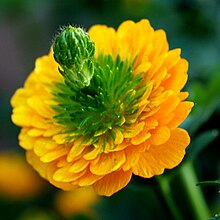Virescence

Virescence is the abnormal development of green
The term was coined around 1825, from
Cause
The main cause of virescence is the presence of phytoplasma, pathogenic microorganisms that infect plants and disrupt their growth. Phytoplasmas often alter normal processes in plants, such as flower color development, leading to virescence.[5] However, there are cases where green flower coloration can also be attributed to genetic factors within the plant itself.
Diagnosing it can be challenging in some cases, as naturally green-colored flowers and genetic factors modifying anthocyanin distribution in plants can mimic its symptoms. For instance, it can be observed in certain Chinese rose varieties and specific clones of periwinkle. While the most notable phytoplasma-associated diseases are commonly reported in commercially grown flowering species, virescence also affects horticultural and seed crops, including tomatoes, cabbages, strawberries, and clover, among others.[6]
Impact
The impacts of virescence can vary depending on the type of plant affected. In commercial flowering plants, virescence can reduce the aesthetic appeal of flowers, potentially impacting their market value and attractiveness to buyers. Additionally, virescence can serve as an indicator of phytoplasma infection, which can cause significant production losses in agricultural and horticultural crops. Therefore, a better understanding of virescence and its influencing factors is crucial for plant disease control and sustainable agriculture management.
See also
- Chlorosis
- Forest pathology
- Phytopathology
References
- ^ Masters, M.T. (1869). Vegetable Teratology, an Account of the Principal Deviations from the Usual Construction of Plants. Robert Hardwicke. p. 240–281.
- ISBN 9781845935306.
- ISBN 9788182051874.
- ^ "Virescent". Academic Dictionaries and Encyclopedias. Retrieved 10 November 2012.
- ISSN 0048-4059.
- PMID 35684198.
